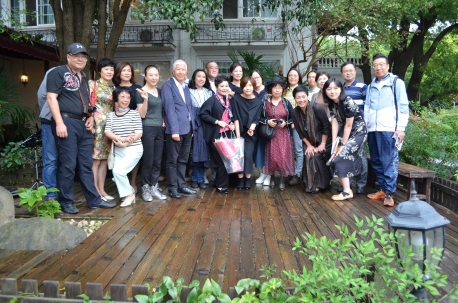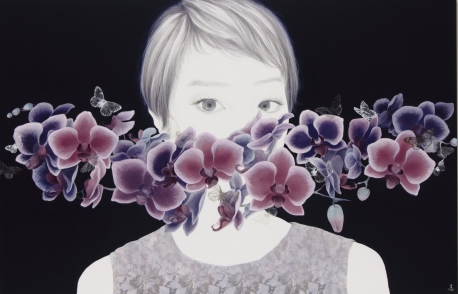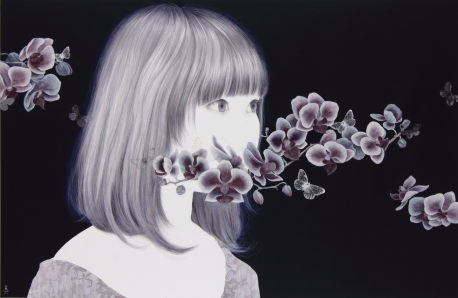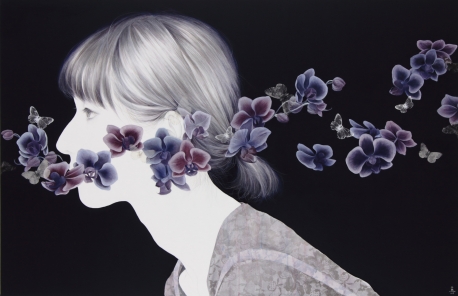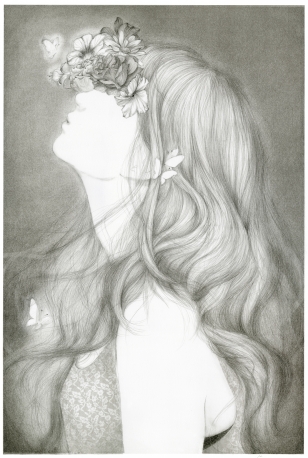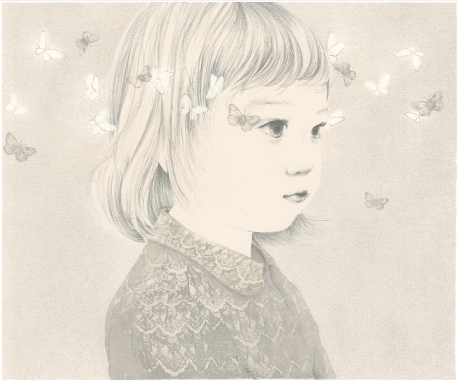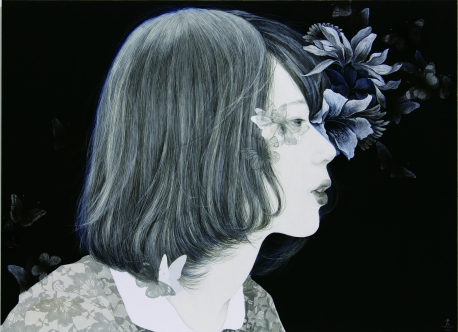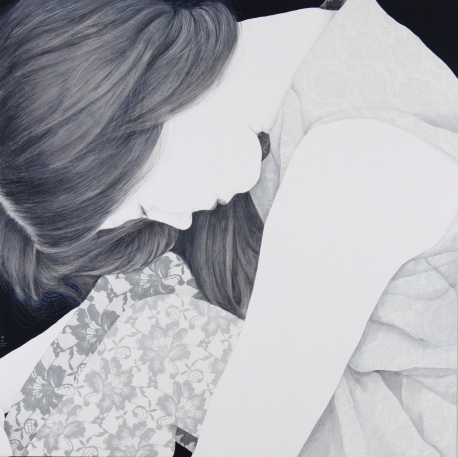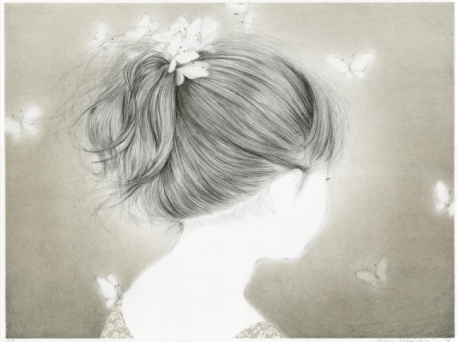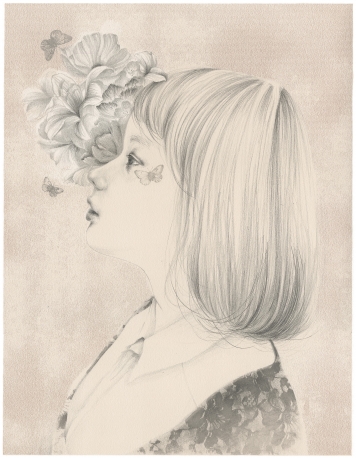- 资质:
- 评分:
1分 2分 3分 4分 5分 6分 7分 8分 9分 10分 10分
- 印象:
- 经营时间:30年
- 展厅面积:400平米
- 地 区:上海-青浦
刺——岩渕华林作品展
- 展览时间:2019-10-05 - 2019-10-23
- 展览城市:上海-青浦
- 展览地点:上海市诸光路888号索美画廊
- 策 展 人:莫芷
- 参展人员:
展览介绍
刺
以外界的目光看,岩渕华林是“神秘疏离”与“宽容兼收”这两种属性完美兼具的画家,她所塑造的女性是“妻性”和“母性”并存的形象,而她自己是这样说的,“在一个人的里面同时并存着各种相互的元素……我想画一个迷人的女人,让女人们自己想要肯定那个女人活得像女人。”她的表述以一种认同而非表达的方式进行着,因此这些女性肖像的存在也就不意味着观看和被观看,自我与它者,更不能理解为客体化的“意象”或父权视野中的“符号化占有”。以符号学的方法去看,花、少女、蝴蝶绝对是无可回避的符号,从“象征”“挪用”,再到“隐喻”,然而实际上,她要传递的并非观念而是自身。一如画中女主角,衣着没有时代,时间凝固,花朵绽放,蝴蝶在粘稠的空气中琥珀般扇动翅膀。她的绘画维持着一种超常的稳定状态,这不应被解释为技术与修养,而是她结实稳固世界观的呈现。与此同时,“飘逸”“诡秘”“纤细”“馥郁”这些词对她也是无效的,在岩渕华林的作品中,不会有时间的前后、距离的长短、欲念、渴望、乃至歌颂,只有清晰的自我意识,从漫漫历史的前夜直到昨天。
在制作上,她巧妙地立足于绘画和版画技法的交叉之地,二种技术交织而无法剥离,她感性地驾驭着不同媒介,不断地用自己的肉身去映射这些形象,以便让人找到它的本原。在真正的女性视野中,不存在纤弱优美的绝对特质,一切只是过程与表象,其内核是不分你我,无有差别。女性主义并不着意于表露某种对抗,而是向我们揭示某种和现有世界无关的,超越的维度。她的绘画不只通过安静乃至寡淡的色彩、恬然神态、娴静气质向我们传递这种平和的能量,而是她作为画者,不断重复着这种生命的稳态循环。就像我们在她的作品中得到了生命的暂歇一般,从笔尖到心上,任由生命平静流逝,心安理得地感受这样随处可见的,甚至几乎要跌入烂俗的平凡美好。
每个女性都被承诺,一生之中必将经历花期,而在这花期也从来应时而发,过时不候。我们也毫无意外地在那时追求美丽、简单与干净,这是所有未曾受过伤害的生命最初的本能。在这里,花、女人、与蝴蝶,一切最精巧最纤弱的事物悉数登场。它在昭示着画家有绝对的无情,一种外人看起来特别羡慕的超然,包括对单一艺术主题的纯真迷恋;而它更昭示着画家绝对的有情,与最美丽的事物为伍而不怕相形见绌,把玩最锋利的刃而不怕伤及自身,只在最温柔处,画出深深一道。
莫芷(清华大学美术学院绘画系助理教授)
2019年8月
Thorn
Looking through the lens of the outside world, Iwabuchi Karin is an artist who perfectly embodies both mysterious distance and extensive openness. Karin’s female figures symbolize both “wifely instincts” and “maternal instincts.” In her words, “There are interactive elements that coexist within a person… I would like to illustrate a charming woman, letting women themselves desire to confirm the womanhood of that woman.” Her statement progresses in an identified but not expressive way. Thus, these female portraits do not mean viewing and being viewed, self and other, nor can we understand them as objectified “image” or “symbolized possession” in the view of patriarchy. From the perspective of semiotics, the flowers, girls, and butterflies are definitely inevitable symbols. However, from “symbolization” and “appropriation”, to “metaphor,” the message Karin intends to deliver is not the concept itself and just like the female figure wearing timeless garments in her painting, in which the time is frozen, flowers are blooming, and butterflies are flapping in the viscous air like inside of an amber. Karin’s paintings sustain a state of extraordinary stableness, which should not be explained as technical mastery, but a demonstration of her strong and solid world view. At the same time, the words such as “flowing,” “mysterious,” “slender,” and “aromatic” are not applicable to Karin’s works, in which there is no temporal sequence, distance, desire, aspiration, nor eulogy. There is only clear self-awareness, from the eve of the long history to yesterday.
Karin nimbly bases her technique on the intersection of painting and printmaking, which interact with each other and cannot be taken apart. She sensibly takes control of different medias, constantly using her own body to reflect those images, so that the viewers can track the origin. In the true female view, the absolute fragility and elegance do not exist—everything is just process and representation. The essence of this view is no different between you and me, nor among everything else. Feminism does not mean to show some kind of confrontation, but to reveal some kind of transcendental dimension that is not related to the current world. Her paintings deliver this peaceful energy to us not merely by the quiet and even plain colors, indifferent countenance, and tranquil temperament, but, as a painter, by incessantly repeating this kind of stable cycle of life. The viewer has gained the moment to briefly pause their daily life when examining Kain’s works, from the penpoint to the heart, letting the life go by peacefully, and feeling free to taste such ordinary, widespread and even platitudinous happiness.
During her life, every woman is promised to experience a blossoming adolescence, which never arrives in time, and waits for no one. At that age we unsurprisingly pursuit beauty, simplicity, and pureness, which is the first instinct of any human being who has never been hurt before. Here, all the most exquisite and fragile things, such as flowers, women, and butterflies, come to the stage. It demonstrates the artist’s absolute cruelness, an enviable detachment consisting of an innocent obsession to a single subject in art. It also shows the artist’s absolute mercy--being with the most beautiful things without worrying about being outshone, just as playing with the sharpest knife without being afraid of hurting herself, only drawing a deep curve on the most tender part.
Mo Zhi(Assistant Professor Academy of Art & Design, Tsinghua University)
August, 2019
岩渕 華林 / Karin IWABUCHI
1985年,出生于日本神奈川
2011年,毕业于东京造型大学
个展
2018年岩渕华林展(东京,椿画廊)
2016年岩渕华林展(台湾台南,德鸿画廊)
2016年岩渕华林展(东京,椿画廊)
2015年岩渕华林展(台湾台南,德鸿画廊)
2014年岩渕华林展(东京,椿画廊)
2012年岩渕华林展(东京,椿画廊)
2009年岩渕华林展(东京,椿画廊)
2009年岩渕华林展(坂巻画廊)
2007年“DRESS ROOM(更衣室)”展(节点)
联展
2017年台北国际艺术博览会(台湾台北)
2016年台北国际艺术博览会(台湾台北)
2016年台北国际当代艺术博览会(台湾台北)
2015年台北国际艺术博展会2015(台湾台北)
2015年台北国际当代艺术博览会(台湾台北)
2014年中艺博国际画廊博览会(中国北京)
2014年台北国际艺术博展会2014(台湾台北)
2013年“绘画·物品·摄影”联展
2013年六本木α艺术周(湘南台画廊)
2012年山本冬彦——优秀女性艺术家展(银座三越)
2012年“亮房间”第十辑(大仓山纪念馆)
2011年第二十届佐藤国际文化奖学金社会展(佐藤博物馆)
2011年第五届“山本鼎”版画奖展(日本长尾县)
2011年“图像的另一面”(麻布十番画廊)
2010年斯帕齐奥瑜伽艺术展(斯帕齐奥瑜伽)
2010年“不会消失的目光,原来的风景”(相模原市城市画廊)
2010年第三十届迷你版画卡达克斯国际展(西班牙)
2010年第九届“Lessedra”世界艺术版画2010年展(保加利亚)
2010年当代艺术收藏(松山,三井)
2010年“Handle(柄)”展(日本,養清堂画廊)
2009年亚洲当代艺术的灵魂(韩国,学古斋画廊)
2009年集中展览(Q画廊)
2009年“Znews(Z新闻)”展(琉球画廊)
2009年部分选展(坂巻画廊)
2009年造型大学毕业展(东京造型大学)
2008年“原始计划”第十辑 岩崎卡琳/菅野静香(坂巻画廊)
2008年“HHHANDO”展(班波多画廊)
2008年“痴迷的对象”展(山手西大厦)
2007年“白色收藏”(大千山纪念馆)
2007年“女校友”(山手西大厦234号)
2007年“凸轮·孪生”展(原宿,猫廼舎)
2007年山手111图书馆(山手西大厦111号)
2007年“亮房间”第3辑(神奈川建民厅)
2006年“亮房间”(山手西大厦234号)
2006年小野纱荣子,岩崎卡琳,吉田惠里卡展(东京造型大学艺术祭)
2006“HHHAN”展(东京造型大学艺术祭)
2006年“横滨风景”(三溪园)
获奖
第三十三届町田市平面艺术城市博物馆——大学艺术与版画研究采购奖
第二十届“佐藤”国际文化奖学金
第五届“山本鼎”版画奖
第十三届国际小型平面设计三年展奖,波兰罗兹市
第三十届迷你版画卡达克斯国际奖(西班牙)
第二届NBC 国际丝印版画双年展奖
第七届三菱公司艺术之门项目奖
资料来源于艺术2009
藏品
町田市平面艺术城市博物馆
Karin IWABUCHI
1985 Born in KANAGAWA,JAPAN
2009 Bachelor of Fine Arts, Tokyo Zokei University
2011 Master of Fine Arts, Tokyo Zokei University
Solo Exhibition
2018 “Blooming” GALLERY TSUBAKI/ Tokyo,JAPAN
2016 “Sprout” Der-Horng Art Gallery /Tainan,TAIWAN
2016 “Iwabuchi Karin Exhibition” GALLERY TSUBAKI/ Tokyo,JAPAN
2015 “Iwabuchi Karin Exhibition” ART GALLERY MUSE/Gunma,JAPAN
2015 “Iwabuchi Karin Exhibition” Der-Horng Art Gallery /Tainan,TAIWAN
2014 “Iwabuchi Karin Exhibition” GALLERY TSUBAKI/ Tokyo,JAPAN
2013 ”Iwabuchi Karin Exhibition” f.e.i art gallery / Yokohama,JAPAN
2012 “Iwabuchi Karin Exhibition” GALLERY TSUBAKI GT2/ Tokyo,JAPAN
2010 “Iwabuchi Karin Exhibition” GALLERY TSUBAKI GT2/ Tokyo,JAPAN
2009 “Iwabuchi Karin Exhibition” Gallery Sakamaki / Tokyo,JAPAN
Group Exhibition
2017”Haruki Murakami inside of me”Gallery Echo-ann/Tokyo,JAPAN
2017”I Am A Cat ”The Sato Museum of Art/Tokyo,JAPAN
2016 “EARLY SUMMER SHOW”GALLERY TSUBAKI/ Tokyo,JAPAN
2016 “GALLERY TSUBAKI REUNION”GALLERY TSUBAKI/ Tokyo,JAPAN
2016 Art Taipei /Taipei,Taiwan
2016 Young Art TAIPEI /Taipei,Taiwan
2015 Art Taipei 2015 /Taipei,Taiwan
2015 Young Art TAIPEI /Taipei,Taiwan
2014 CIGE/Beigin,China
2014 Art Taipei 2014 /Taipei,Taiwan
2014 Young Art TAIPEI /Taipei,Taiwan
2013 “Group Exhibition “PAINTINGS, OBJECTS, and PHOTOGRAPHS”GALLERY TSUBAKI/ Tokyo,JAPAN
2013 “ROPPONGI α ART WEEK”Shonandai MY Gallery/ Tokyo,JAPAN
2012”The female artist exhibition of a gem by Fuyuhiko YAMAMOTO”MITSUKOSHI-GINZA GALLERY/Tokyo,JAPAN
2012 “Light room vol.10” Okurayama memorial holl/Yokohama,JAPAN
2011 “20th SATO international culture scholarship society exhibition” The Sato Museum of Art/Tokyo,JAPAN
2011 “5th YAMAMOTO Kanae prints award exhibition”Ueda City Art Museum/Nagano,JAPAN
2011 Young Art TAIPEI /Taipei,Taiwan
2010 “30th MINI PRINT INTERNATIONAL OF CADAQUES”/SPAIN
2010 “9th Lessedra World Art Print Annual2010”/BULGARIA
2010 “Contemporary Art collection”MITSUKOSHI Matsuyama/Ehime,JAPAN
2009 “Soul of Asian Contemporary Art”Hakojae Gallery/KOREA
2009 “The Concentration Exhibition”Gallery Q/Tokyo,JAPAN
2009 “Small Selections”gallery Sakamaki/Tokyo,JAPAN
2008 “Original Program vol.10 Iwabuchikarin/KannoShizuka”gallery Sakamaki/Tokyo,JAPAN
2008 “Obsessional Object”Western Mansion Yamate/Yokohama,JPAN
2007 “White Collection”OHKURAYAMA MEMORIAL/Yokohama,JPAN
2007 “Yamate 111 Library”Western Mansion Yamate111/Yokohama,JPAN
2007 “Lightroom vol.3”KANAGAWA KENMIN HOLL/Yokohama,JPAN
Prize
1th FEI PRINT AWARD Audience choice award
33th University of Art&print Studies Machida City Museum of Graphic Arts Purchase prize
35th University of Art&print Studies Machida City Museum of Graphic Arts Purchase prize
Collection
Machida City Museum of Graphic Arts
岩渕华林创作问答
岩渕华林 2019.7.8
对于当前的创作,媒介(绘画,雕塑,版画等等),主题,材料,技术,以及它们的相关性
关于媒介
我一直在带有岩面漆和和丙烯酸的和纸上作画,也用丝网印刷和平板印刷作版画,这两者同时用于我的创作。当我画一幅画时,我会完成版画中不能完成的部分(为了画一条线的专注和精神力量,或连续且细致的刻画)。另外,当在印制版画时,我暗示着各种媒介,并意识到那些在绘画中无法完成的部分(装饰性、清晰的图案和颜色或是轻薄的质地)。曾经有段时间,我试图把绘画和版画分开,但是我意识到,绘画中带有版画和版画中带有绘画这一创作过程,应该是一种属于我自己的绘画力量。
关于主题
蝴蝶,鲜花,女人和我所画的一切:所有这些的共同点便是变化的象征。在她的一生中,一个女孩最终会成为女人,不仅要结婚或生育,而且女人也经常被要求去适应变化。据说,汉字“华(花)”用简体中文可以写成“十(十)”和“化(成熟)”。我很好奇当一只蛹变成蝴蝶时,它在想些什么。我希望我能画一幅关于人类生命的画,包括“华(花)”背后的矛盾。 最后,我想画一个迷人的女人,让女人们自己想要肯定那个女人活得像女人。
关于材料
我在白麻纸和高知和纸上使用丙烯酸、岩面漆和油墨。在这幅手绘作品的顶部,丝绸纸上的丝印图案或蝴蝶是粘贴在拼贴画上的。我在日本画中用的是一把刷子(主要用的是面相笔)。我用接近单色的颜色来完成的画作的原因,是因为一个人的皮肤部分是通过在和纸空白处留下的眼睛来展示的,所以黑色经常被最大限度地利用,来呼应和纸本身的纯白。此外,我认为黑色是最好的颜色,它代表着一个坚强且优雅的女性形象,而这个女性形象包含了所有的颜色,却又不是所有的颜色。
就是这样。
Karin IWABUCHI
Iwabuchi Kabayashi 2019.7.8
For current production, media (e.g., paintings, sculptures, engravings, etc.), motifs, materials, techniques, and their relevance
·About media
I have been working in parallel with paintings drawn on Japanese paper with rock paints and acrylics, as well as prints using silk screens and lithographs.When drawing a painting, I did the part that cannot be done in the print (concentration and mental power in order to draw one line, or persistent detailed depiction). Also, when printing a print, I imply various media, being conscious of the parts which cannot be done in the painting (decorativeness, clear design and color or light texture). There were times when I tried to separate painting from print, but I think that going through the process of painting carried by print and print carried by painting should be a strength in making my own drawing.
·About motif
Butterflies, flowers, women and the everything I draw: the common denominator of all of them is a symbol of change. Throughout her days, a girl will eventually become women and not only marry or give birth, but also women are often asked to adapt to change. It is said that the kanji character "華(flower)" is written in simplified Chinese as "十(ten)" and "化ける(mature)". I wonder what a pupa thinks when it turns into a butterfly. I hope that I can draw a painting of people's lives, including the conflicts behind "華(flower)". Eventually, I would like to paint a fascinating woman that women themselves would like to affirm that women living as women.
·About materials
I use acrylics, rock paints, and ink on white hemp paper and Kochi Japanese paper.On top of this hand-drawn work, a pattern or butterfly silkscreen on a silk paper is pasted in collage.I use a brush for Japanese painting (mainly mensoufude).The reason for finishing with colors close to monochrome is that the skin part of a person is represented by leaving the eyes of Japanese paper blank, so the black is often used to make the best use of the whiteness of the Japanese paper itself. Also, I think that black is the best color to represent a strong and delicate female image that includes all the colors, but not all the colors.
That's it.
Karin Iwabuchi

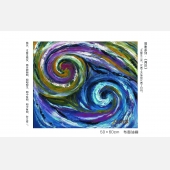 庞明璇
庞明璇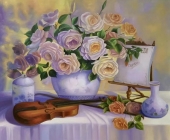 未知
未知 张大千
张大千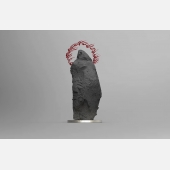 马文甲
马文甲 李秀勤
李秀勤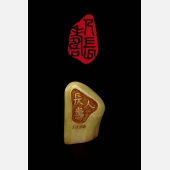 陈维廉
陈维廉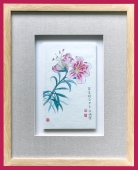 赵映璧
赵映璧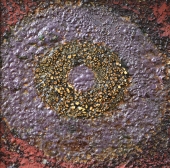 魏新
魏新





